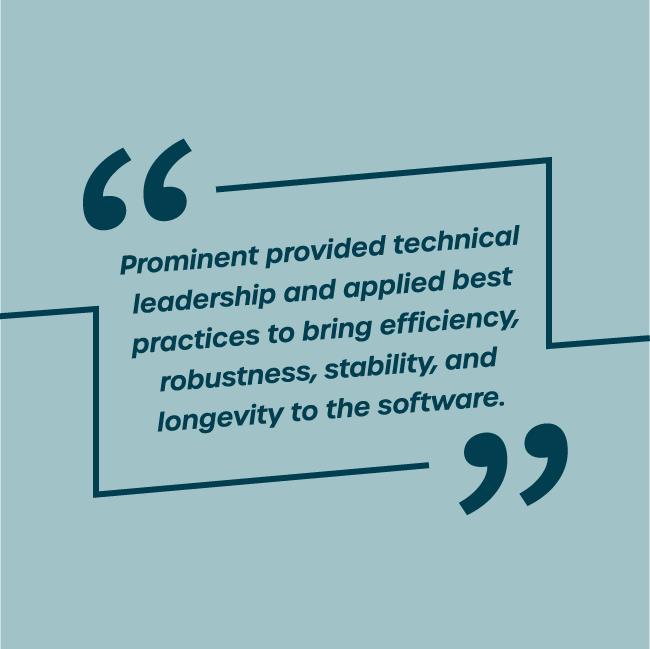If you travel often, you’ve probably flown on airplanes like the Boeing 777. Fitting hundreds of passengers, this airplane flies smoothly and safely thanks to the wires that operate nearly every aspect of it.
If you removed all of the wires from the 777 and strung them end-to-end, they would connect Bismarck and Minot, North Dakota – spanning a distance of over 110 miles.
The client is a manufacturer that compiles and groups the wiring for airplanes like this. They also manufacture electronic circuit board assemblies, harnesses, and ground support equipment for military and aerospace clients including Boeing, Raytheon, and Lockheed Martin.
One of the client’s values is Perpetual Improvement; they are constantly looking for ways to increase efficiency while maintaining outstanding accuracy. While their reputation of ongoing improvement remains strong, the internal software development team was struggling to make progress on high-priority software efforts that would further improve efficiency.
They ran into the problem of having a significant amount of work that still needed to be completed and the software tools on which they were relying had limited functionality. That’s where our team at Prominent came in – providing technical leadership and applying best practices to bring efficiency, robustness, stability, and longevity to their software to drive return on investment and ensure measurable growth into the future.

Why This Manufacturing Company Needed Custom Software
The client recognized they needed software that was acutely secure, able to process large wire-mapping files quickly, and could accommodate a variety of potential future improvements as they grew. No existing software package had been able to tackle all of their requirements, so they pursued custom software.
Prominent performed a solution roadmap to deeply assess their current situation, envision possible solutions, and provide the client with options on how to achieve their goals.
The solution roadmap was focused on their most important software: the Shop Aid Management System (SAMS). This system would convert wire bundle requests into instructions that engineers would use to assemble the wires and cables accurately for specific jobs.
Opportunities the Solution Roadmap Discovered
While their previous system met some of their needs, it didn’t support new wire bundle requests. This left the client without instructions on how to assemble new products, dramatically increasing employee assembly time as well as chances of human error.
The internal development team was working on updating their existing software to allow for new requests, but it had an unstable foundation and they were unable to complete the changes. It became clear the software would eventually need a significant revision to fix the inefficiencies and limitations.
Our Software Recommendations
After learning about the company’s values, needs, and current state, Prominent presented them with three options:
- Finish the current software application that their team was developing. This system wouldn’t last them for the long haul, but they could use it until a new system could be developed.
- Build a new but basic software application that we could enhance over time.
- Develop a new, fully-featured software application for improving long-term efficiency and process improvement.
Because of our deep understanding of the client’s pain points and goals, we recommended and moved forward with the third option.
What We Developed
In less than a year, our team at Prominent built a user-friendly system that converts complex customer requests into easy-to-follow instructions.
The system seamlessly guides users through the creation process, allowing for approval workflows and defined processes to ensure that it creates accurate instructions. We integrated with existing machinery to further streamline and ensure accuracy with how the products are manufactured in relation to its instructions. It was no easy feat but our team took a very complex system and broke it down on the front-end so the user’s experience is simple and efficient.
The Results
We delivered the project on time and within budget, while adding an array of additional features and functionality. The system allowed company employees to build a set of instructions faster, allowing for multiple people to work on instructions while reducing human errors and redundancy. This simplified their team’s workflow while substantially improving efficiency.
The Team and Technology to Make it Successful
We successfully executed this project using a technical stack involving SQL Server, .NET Core, Vue.js, and SSIS. The system also integrates with MS Dynamics. Within this project, our team includes the following roles:
Project Manager
Business Analyst
Developer
Developer Lead
UI/UX Designer
Quality Assurance
Why it Worked
Several elements of the project made it successful.
- Proper Planning
A thorough solution roadmap allowed us to understand and prioritize software efforts before we got started. This allowed us to move forward with custom software that brings the highest return on investment and that aligns with their goals as a company.
- Our Relationship
We have a strong working relationship with the engineering team. This allowed us to understand their day-to-day pain-points and develop software to address them.
- We’re Curious
The client is an extremely technical company. Using our tenacity and ambition, coupled with curiosity, we were able to understand the depth and complexity of why their previous software acted in certain ways and identify areas to optimize. This allowed us to simplify their processes and develop a system that truly meets their needs.
- Complexity made Easy
Our expert designers and architects built the client intricate software that is easy and intuitive to use.
Conclusion
By planning, asking questions, and cultivating a strong partnership with our client, we were able to build an extremely complex application that provided immediate value to the company.
Overall this project provided a solid foundation for their future application development, allowing us to later develop modules to enhance efficiency in other internal departments.





